towing TOYOTA CAMRY 2019 Owners Manual (in English)
[x] Cancel search | Manufacturer: TOYOTA, Model Year: 2019, Model line: CAMRY, Model: TOYOTA CAMRY 2019Pages: 612, PDF Size: 11.44 MB
Page 3 of 612

3
1
8 7 5 4
3
2
CAMRY_U
9
6
3-1. Key informationKeys .................................. 134
3-2. Opening, closing and locking the doors
Doors................................. 143
Trunk ................................. 152
Smart key system.............. 157
3-3. Adjusting the seats Front seats ........................ 166
Rear seats ......................... 168
Head restraints .................. 170
3-4. Adjusting the steering wheel and mirrors
Steering wheel .................. 172
Inside rear view mirror....... 174
Outside rear view mirrors ............................. 176
3-5. Opening and closing the windows
Power windows ................. 178
Moon roof .......................... 182
Panoramic moon roof ........ 186 4-1. Before driving
Driving the vehicle ............. 192
Cargo and luggage ............ 200
Vehicle load limits .............. 203
Trailer towing ..................... 204
Dinghy towing .................... 205
4-2. Driving procedures Engine (ignition) switch (vehicles without a
smart key system) ........... 206
Engine (ignition) switch (vehicles with a
smart key system) ........... 208
Automatic transmission ..... 213
Turn signal lever ................ 219
Parking brake .................... 220
Electric parking brake ........ 221
Brake Hold ......................... 225
4-3. Operating the lights and wipers
Headlight switch ................ 227
Automatic High Beam ........ 231
Windshield wipers and washer ...................... 235
4-4. Refueling Opening the fuel tank cap ........................... 239
3Operation of each
component4Driving
Page 16 of 612
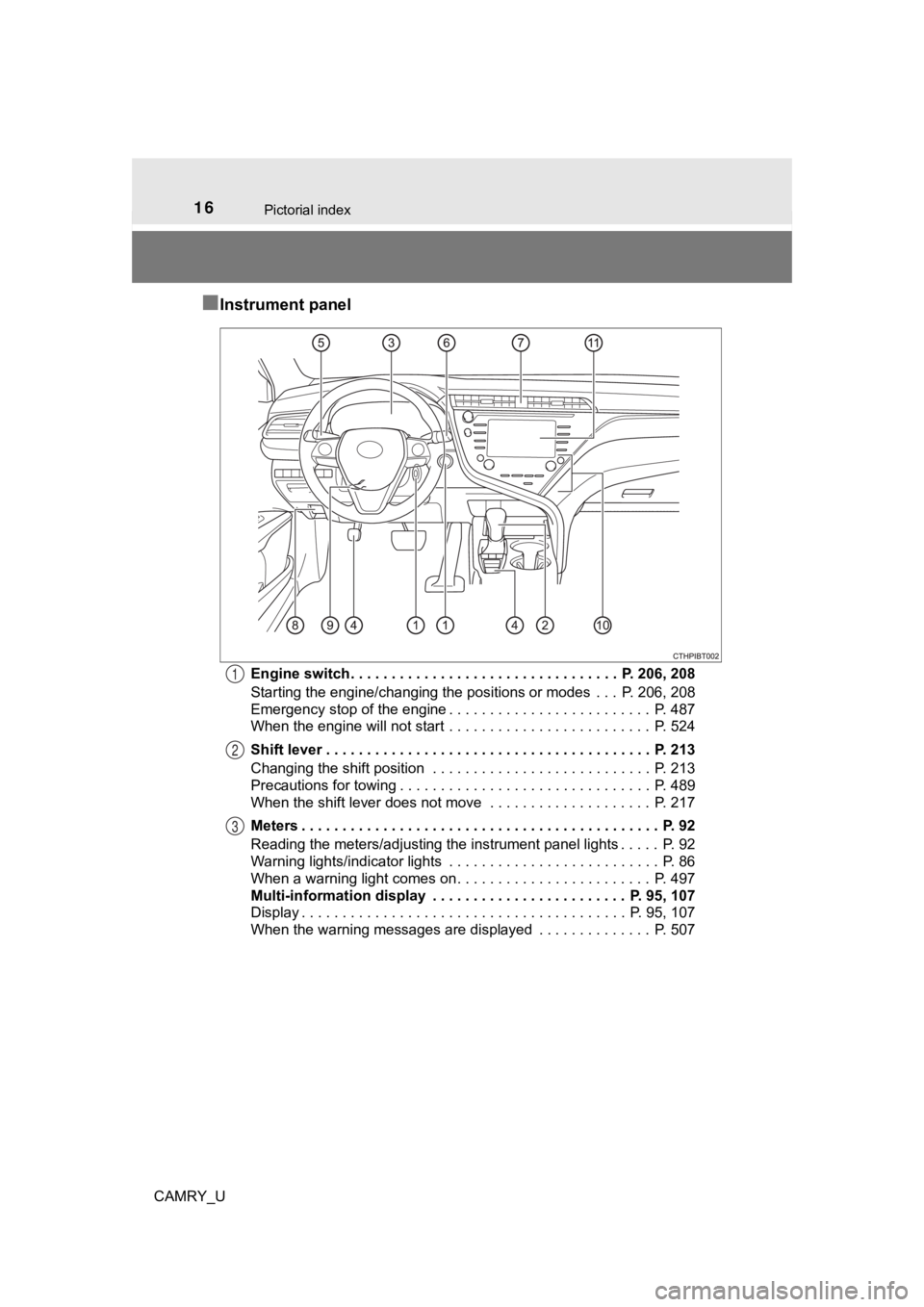
16Pictorial index
CAMRY_U
■Instrument panel
Engine switch . . . . . . . . . . . . . . . . . . . . . . . . . . . . . . . . . P. 206, 208
Starting the engine/changing the positions or modes . . . P. 206, 208
Emergency stop of the engine . . . . . . . . . . . . . . . . . . . . . . . . . P. 487
When the engine will not start . . . . . . . . . . . . . . . . . . . . . . . . . P. 524
Shift lever . . . . . . . . . . . . . . . . . . . . . . . . . . . . . . . . . . . . . . . . P. 213
Changing the shift position . . . . . . . . . . . . . . . . . . . . . . . . . . . P. 213
Precautions for towing . . . . . . . . . . . . . . . . . . . . . . . . . . . . . . . P. 489
When the shift lever does not move . . . . . . . . . . . . . . . . . . . . P. 217
Meters . . . . . . . . . . . . . . . . . . . . . . . . . . . . . . . . . . . . . . . . . . . . P. 92
Reading the meters/adjusting the instrument panel lights . . . . . P. 92
Warning lights/indicator lights . . . . . . . . . . . . . . . . . . . . . . . . . . P. 86
When a warning light comes on . . . . . . . . . . . . . . . . . . . . . . . . P. 497
Multi-information display . . . . . . . . . . . . . . . . . . . . . . . . P. 95, 107
Display . . . . . . . . . . . . . . . . . . . . . . . . . . . . . . . . . . . . . . . . P. 95, 107
When the warning messages are displayed . . . . . . . . . . . . . . P. 5071
2
3
Page 65 of 612
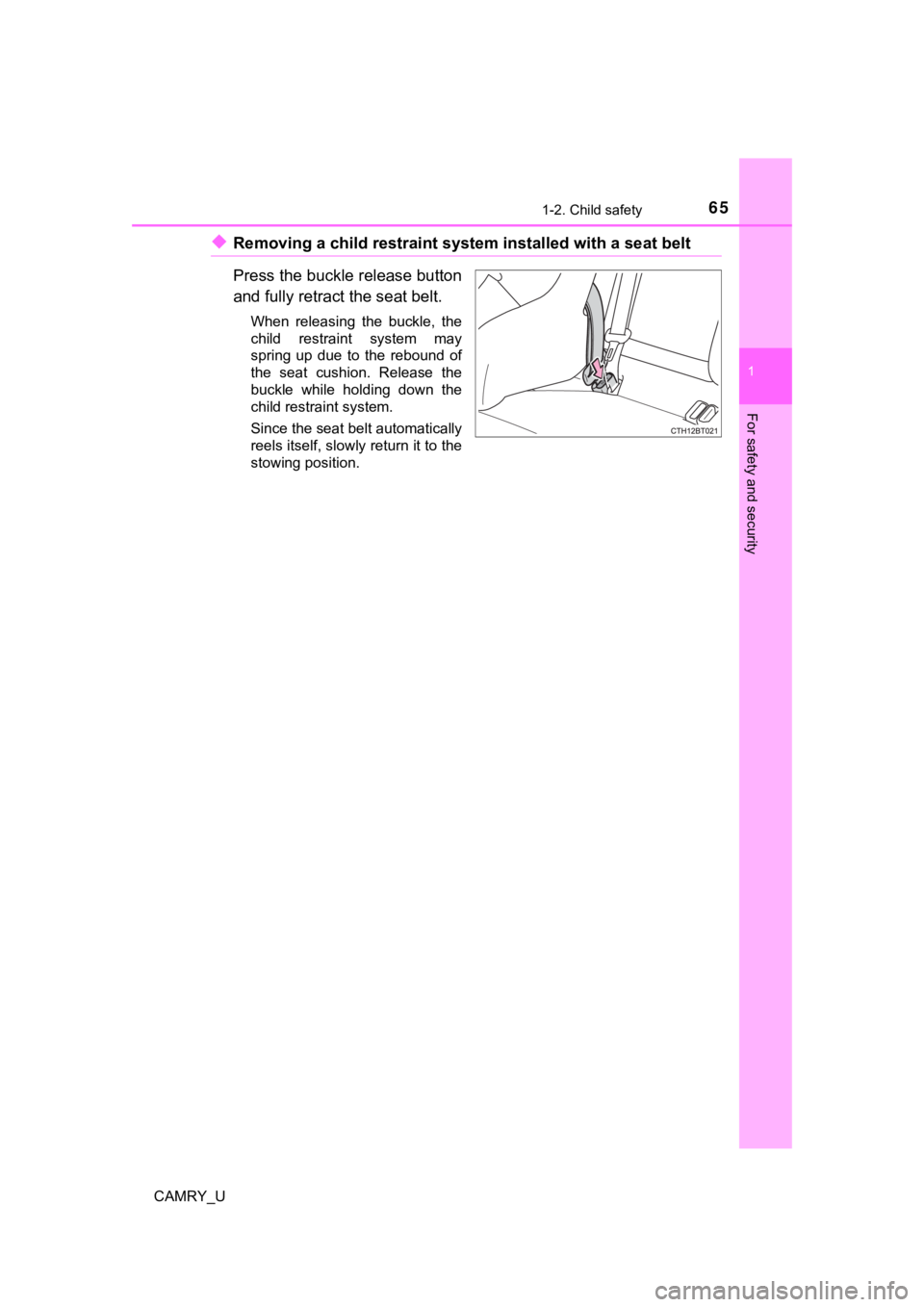
651-2. Child safety
1
For safety and security
CAMRY_U
◆Removing a child restraint system installed with a seat belt
Press the buckle release button
and fully retract the seat belt.
When releasing the buckle, the
child restraint system may
spring up due to the rebound of
the seat cushion. Release the
buckle while holding down the
child restraint system.
Since the seat belt automatically
reels itself, slowly return it to the
stowing position.
Page 77 of 612
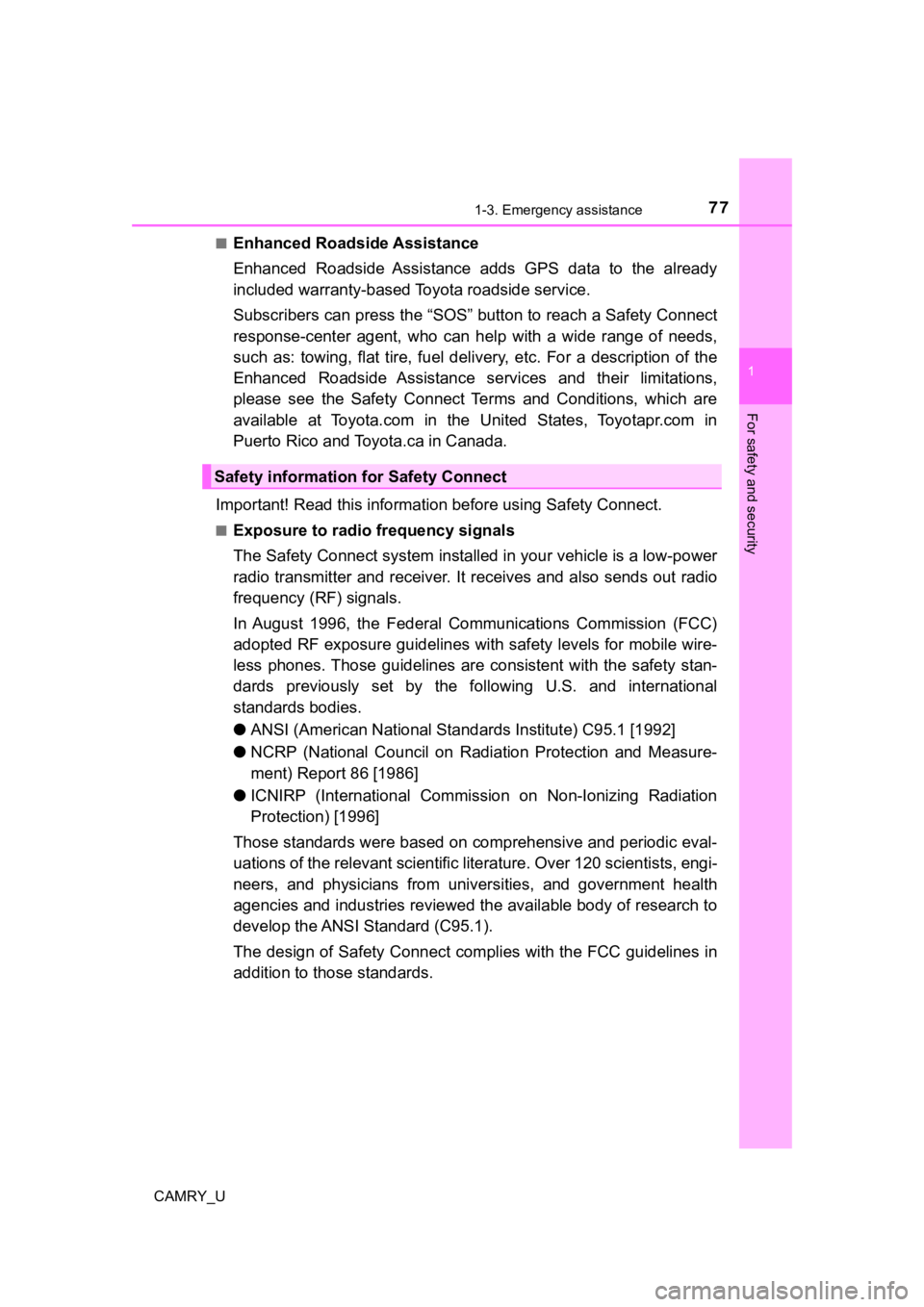
771-3. Emergency assistance
1
For safety and security
CAMRY_U■
Enhanced Roadside Assistance
Enhanced Roadside As
sistance adds GPS data to the already
included warranty-based Toyota roadside service.
Subscribers can press the “SOS” button to reach a Safety Connec t
response-center agent, who can he lp with a wide range of needs,
such as: towing, flat tire, fuel delivery, etc. For a description of the
Enhanced Roadside Assistance se rvices and their limitations,
please see the Safety Connect Te rms and Conditions, which are
available at Toyota.com in the United States, Toyotapr.com in
Puerto Rico and Toyota.ca in Canada.
Important! Read this informatio n before using Safety Connect.
■Exposure to radio frequency signals
The Safety Connect system installed in your vehicle is a low-po wer
radio transmitter and receiver. I t receives and also sends out radio
frequency (RF) signals.
In August 1996, the Federal Communications Commission (FCC)
adopted RF exposure guidelines with safety levels for mobile wi re-
less phones. Those guidelines are consistent with the safety stan-
dards previously set by the following U.S. and international
standards bodies.
● ANSI (American National Stand ards Institute) C95.1 [1992]
● NCRP (National Council on Radi ation Protection and Measure-
ment) Report 86 [1986]
● ICNIRP (International Commission on Non-Ionizing Radiation
Protection) [1996]
Those standards were based on comprehensive and periodic eval-
uations of the relevant scienti fic literature. Over 120 scientists, engi-
neers, and physicians from unive rsities, and government health
agencies and industries reviewed the available body of research to
develop the ANSI Standard (C95.1).
The design of Safety Connect complies with the FCC guidelines i n
addition to those standards.
Safety information for Safety Connect
Page 191 of 612

191
4Driving
CAMRY_U4-1. Before driving
Driving the vehicle ............. 192
Cargo and luggage ........... 200
Vehicle load limits ............. 203
Trailer towing..................... 204
Dinghy towing ................... 205
4-2. Driving procedures Engine (ignition) switch (vehicles without a
smart key system) ........... 206
Engine (ignition) switch (vehicles with a
smart key system) ........... 208
Automatic transmission ..... 213
Turn signal lever................ 219
Parking brake .................... 220
Electric parking brake........ 221
Brake Hold ........................ 225
4-3. Operating the lights and wipers
Headlight switch ................ 227
Automatic High Beam ....... 231
Windshield wipers and washer ..................... 235
4-4. Refueling Opening the fuel tank cap .......................... 239 4-5. Using the driving
support systems
Toyota Safety Sense P ..... 243
PCS (Pre-Collision System) .... 250
LDA (Lane Departure Alert with steering
control) ............................ 261
Dynamic radar cruise control with full-speed
range............................... 271
Dynamic radar cruise control ............................. 285
Cruise control .................... 299
Driving assist systems ...... 304
BSM (Blind Spot Monitor) ........ 310
• BSM function ................ 314
• RCTA function .............. 316
Rear Camera Detection Function .......................... 320
Intuitive parking assist....... 324
Intelligent Clearance Sonar (ICS) ..................... 332
Driving mode select switches .......................... 353
4-6. Driving tips Winter driving tips ............. 355
Page 200 of 612
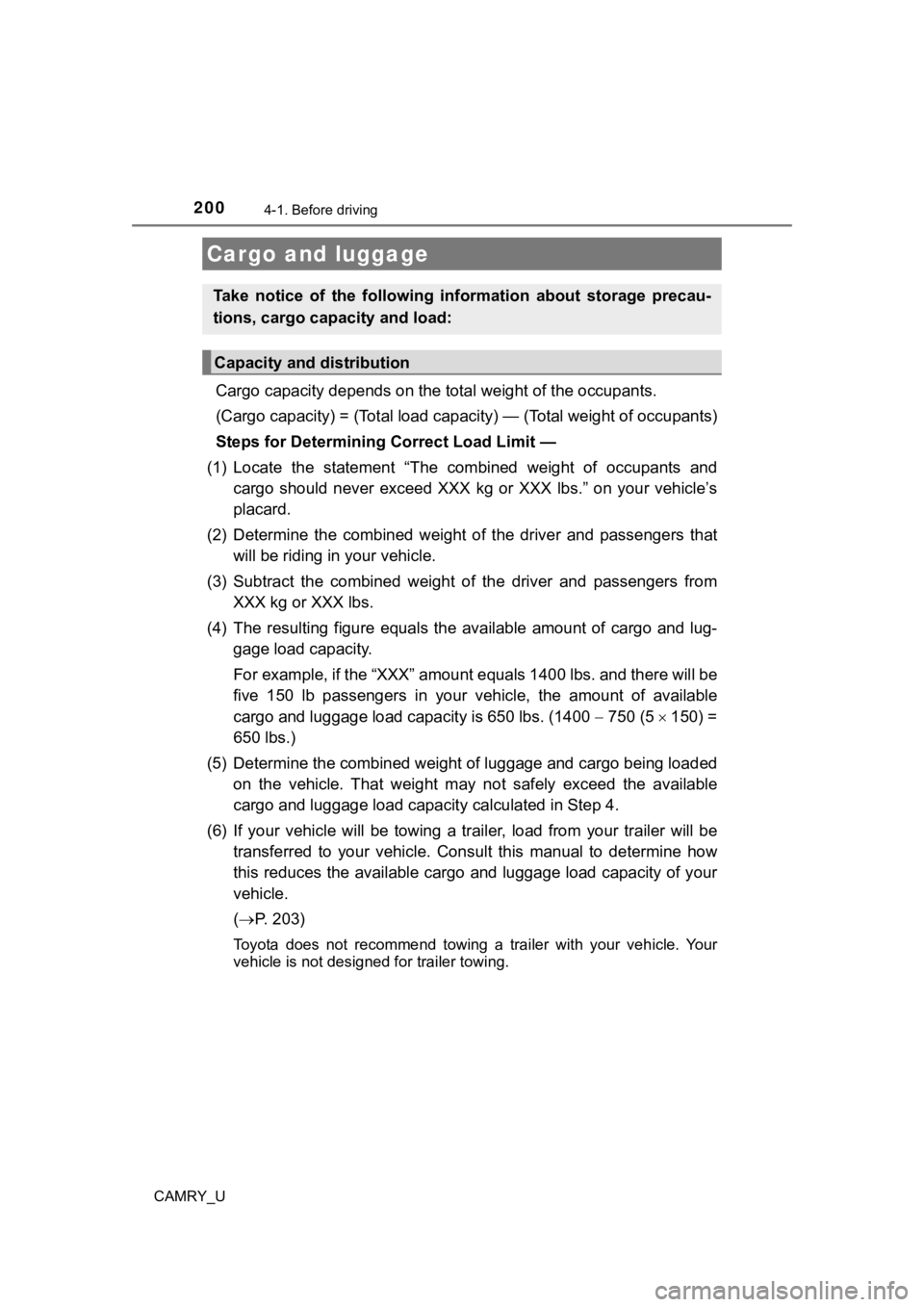
2004-1. Before driving
CAMRY_U
Cargo capacity depends on the total weight of the occupants.
(Cargo capacity) = (Total load capacity) — (Total weight of occ upants)
Steps for Determining Correct Load Limit —
(1) Locate the statement “The co mbined weight of occupants and
cargo should never exceed XXX kg or XXX lbs.” on your vehicle’s
placard.
(2) Determine the combined weight of the driver and passengers t hat
will be riding in your vehicle.
(3) Subtract the combined weight of the driver and passengers fr om
XXX kg or XXX lbs.
(4) The resulting figure equals the available amount of cargo an d lug-
gage load capacity.
For example, if the “XXX” amount equals 1400 lbs. and there wil l be
five 150 lb passengers in your vehicle, the amount of available
cargo and luggage load capacity is 650 lbs. (1400 750 (5150) =
650 lbs.)
(5) Determine the combined weight of luggage and cargo being loa ded
on the vehicle. That weight may n ot safely exceed the available
cargo and luggage load capac ity calculated in Step 4.
(6) If your vehicle will be towing a trailer, load from your tra iler will be
transferred to your vehicle. Consult this manual to determine h ow
this reduces the available cargo and luggage load capacity of y our
vehicle.
( P. 203)
Toyota does not recommend towing a trailer with your vehicle. Y our
vehicle is not desig ned for trailer towing.
Cargo and luggage
Take notice of the following information about storage precau-
tions, cargo capacity and load:
Capacity and distribution
Page 203 of 612
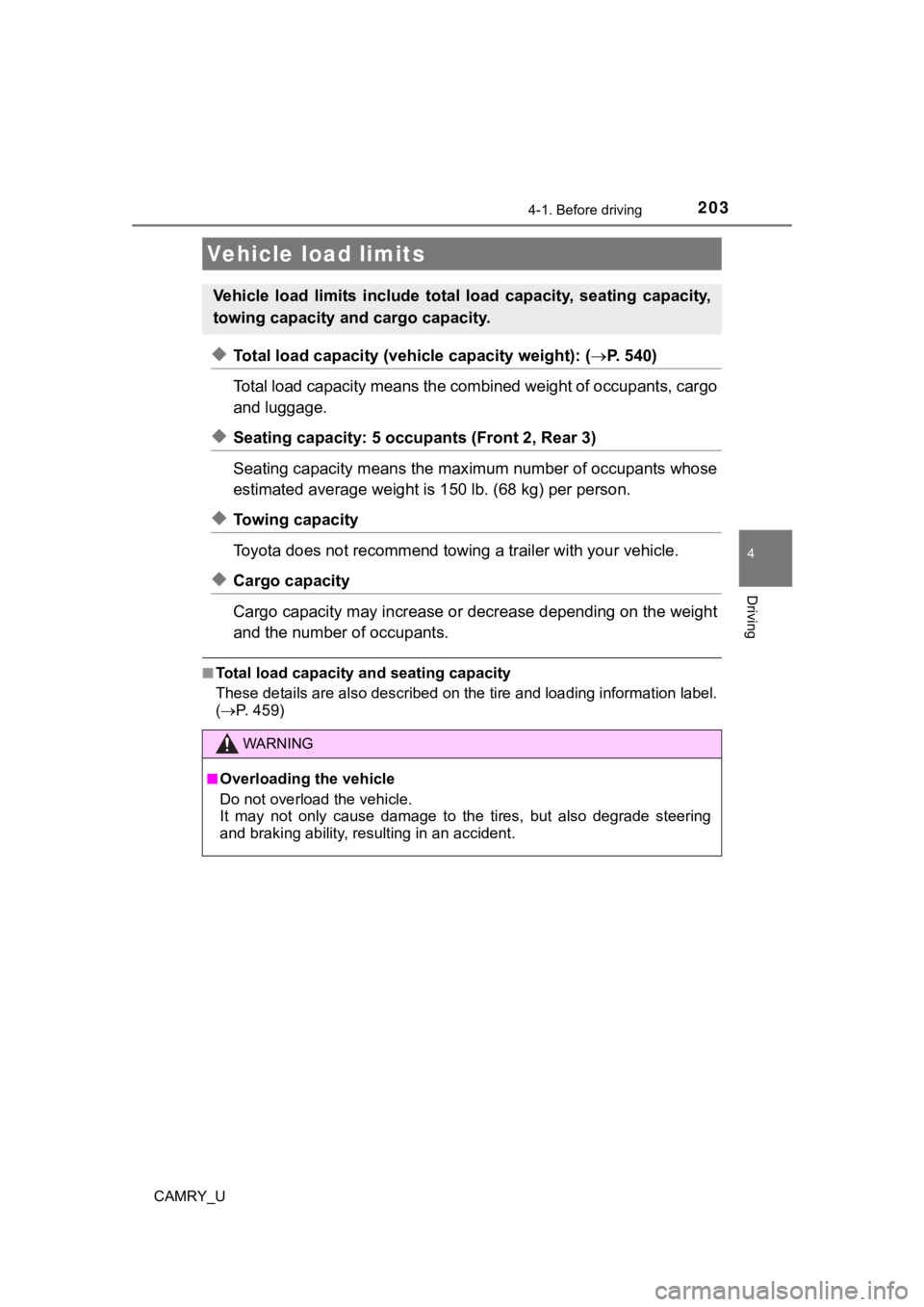
2034-1. Before driving
4
Driving
CAMRY_U
◆Total load capacity (vehicle capacity weight): (P. 5 4 0 )
Total load capacity means the co mbined weight of occupants, cargo
and luggage.
◆Seating capacity: 5 occupants (Front 2, Rear 3)
Seating capacity means the max imum number of occupants whose
estimated average weight is 1 50 lb. (68 kg) per person.
◆Towing capacity
Toyota does not recommend towing a trailer with your vehicle.
◆Cargo capacity
Cargo capacity may increase or decrease depending on the weight
and the number of occupants.
■Total load capacity and seating capacity
These details are also described on the tire and loading inform ation label.
( P. 459)
Vehicle load limits
Vehicle load limits include total load capacity, seating capaci ty,
towing capacity and cargo capacity.
WARNING
■Overloading the vehicle
Do not overload the vehicle.
It may not only cause damage to the tires, but also degrade steering
and braking ability, res ulting in an accident.
Page 204 of 612
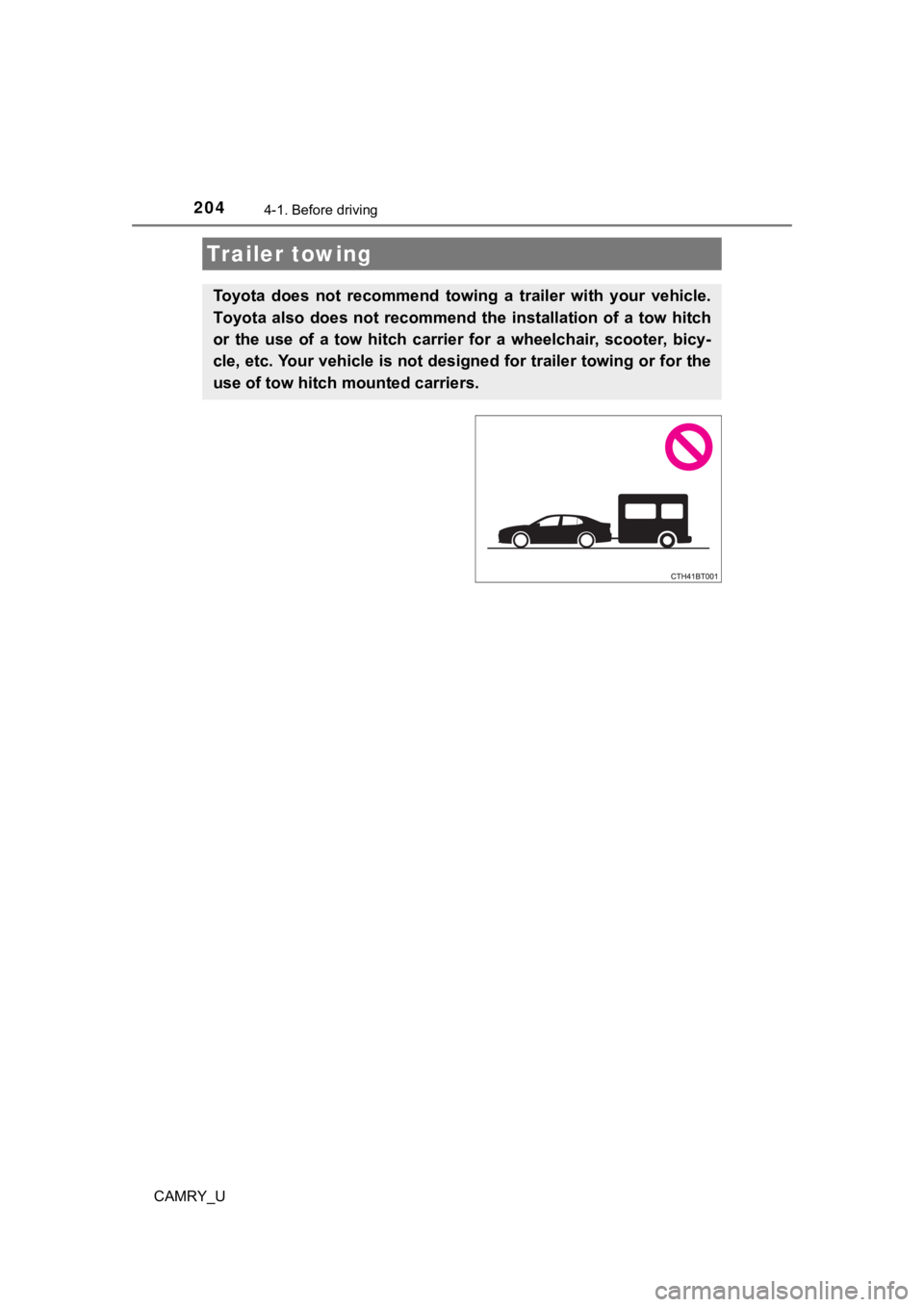
2044-1. Before driving
CAMRY_U
Trailer towing
Toyota does not recommend towing a trailer with your vehicle.
Toyota also does not recommend the installation of a tow hitch
or the use of a tow hitch carrier for a wheelchair, scooter, bi cy-
cle, etc. Your vehicle is not des igned for trailer towing or for the
use of tow hitch mounted carriers.
Page 205 of 612
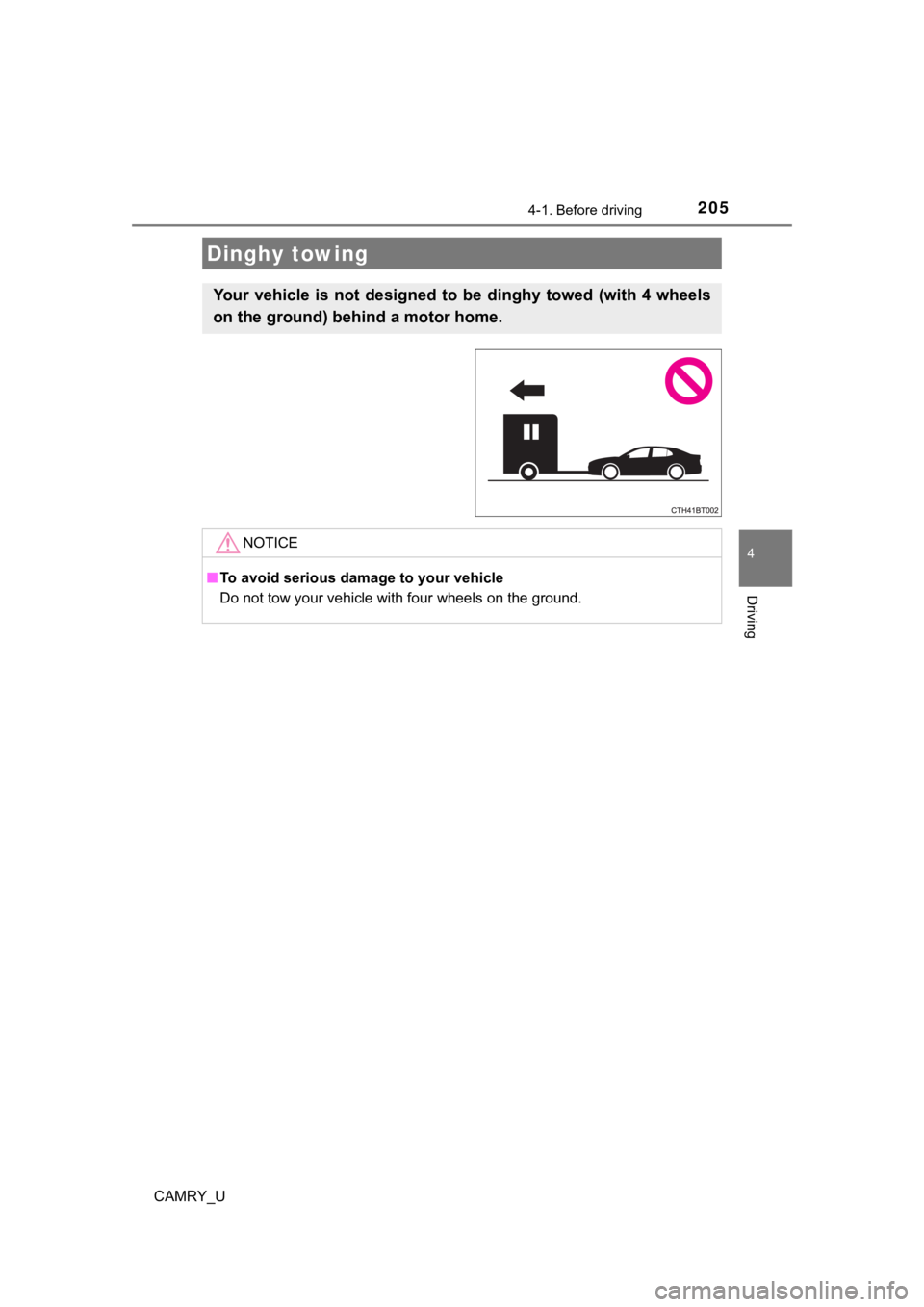
2054-1. Before driving
4
Driving
CAMRY_U
Dinghy towing
Your vehicle is not designed to be dinghy towed (with 4 wheels
on the ground) behind a motor home.
NOTICE
■To avoid serious damage to your vehicle
Do not tow your vehicle with four wheels on the ground.
Page 252 of 612

2524-5. Using the driving support systems
CAMRY_U
WARNING
■When to disable the pre-collision system
In the following situations, disable the system, as it may not operate prop-
erly, possibly leading to an accident resulting in death or ser ious injury:
● When the vehicle is being towed
● When your vehicle is towing another vehicle
● When transporting the vehicle via truck, boat, train or similar means of
transportation
● When the vehicle is raised on a lift with the engine running an d the tires
are allowed to rotate freely
● When inspecting the vehicle using a drum tester such as a chass is dyna-
mometer or speedometer tester, or when using an on vehicle whee l bal-
ancer
● When a strong impact is applied to the front bumper or front gr ille, due to
an accident or other reasons
● If the vehicle cannot be driven in a stable manner, such as when the vehi-
cle has been in an accident or is malfunctioning
● When the vehicle is driven in a sporty manner or off-road
● When the tires are not properly inflated
● When the tires are very worn
● When tires of a size other than specified are installed
● When tire chains are installed
● When a compact spare tire or an emergency tire puncture repair kit is used
● If equipment (snow plow, etc.) that may obstruct the radar sens or or cam-
era sensor is temporarily installed to the vehicle